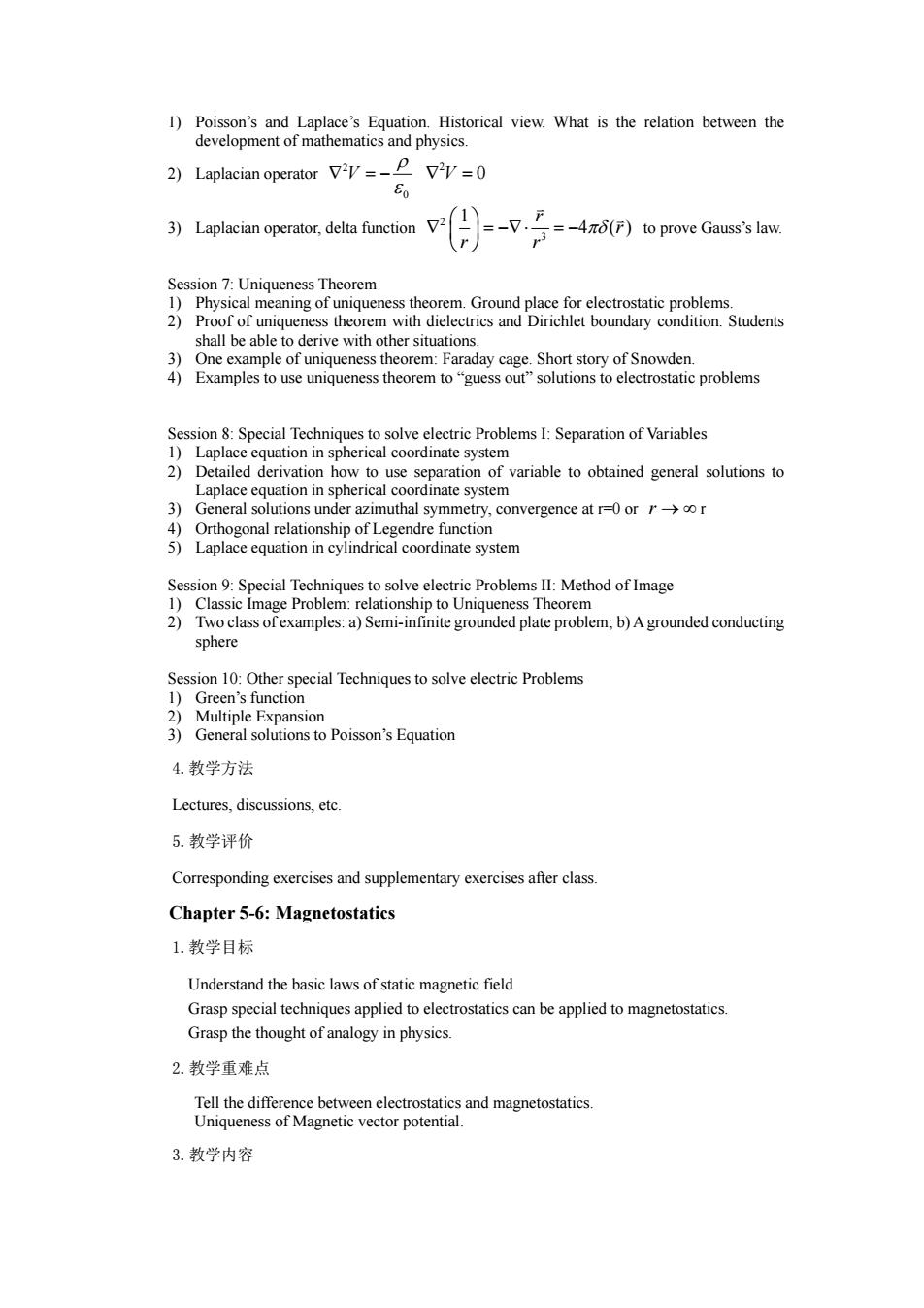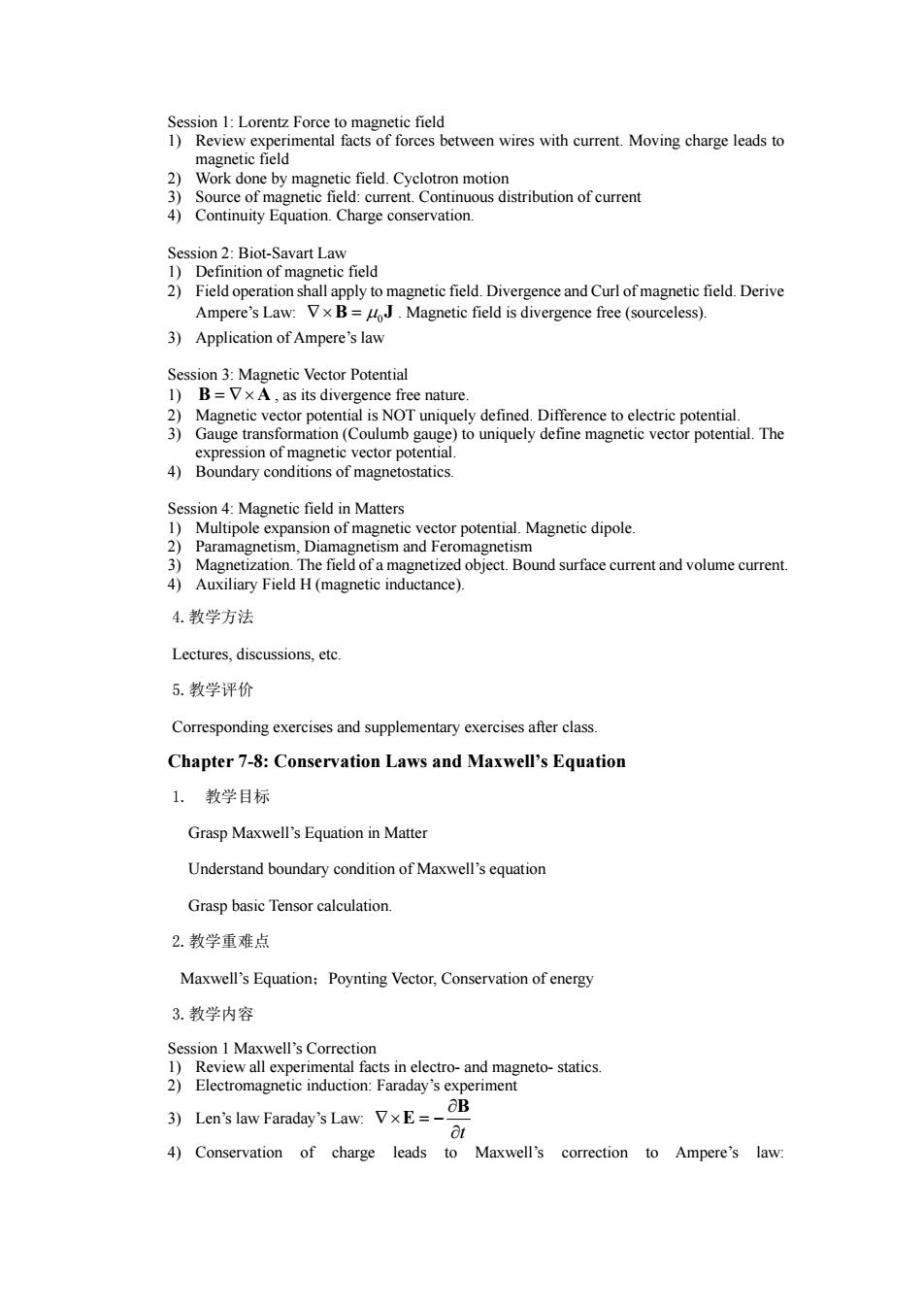
1)Poisson's and Laplace's Equation.Historical view.What is the relation between the development of mathematics and physics. 2)Laplacian operator=-P=0 7.Ini 2)Proof ofq ess the rem with dielectrics and Dirichlet boundary condition.Students hall be 4)Examples to use uniqueness theorem to"guess out"solutions to electrostatic problems Lappcal Techniques to solve electric Problems 1:Separationo on in sp Laplace ation in spherical coordinate variable to obtained general solutions to vstem ns under a☑ zimuthal symmetry,convergence at -0or stem )ooundd oducine sphere Session 10:Other special Techniques to solve electric Problems 》Green's.Function eeroisquio 4.教学方法 Lectures.discussions.ete 5.教学评价 Corresponding exercises and supplementary exercises after class Chapter 5-6:Magnetostatics 1.教学目标 Understand the basic as of static magnetic field Grasp special techniques applied to electrostatics can be applied to magnetostatics. Grasp the thought of analogy in physics. 2.教学重难点 Tell the difference between electrostatics and magnetostatics Uniqueness of Magnetic vector potential. 3.教学内容
1) Poisson’s and Laplace’s Equation. Historical view. What is the relation between the development of mathematics and physics. 2) Laplacian operator 2 0 V 2 V 0 3) Laplacian operator, delta function 2 3 1 4 () r r r r to prove Gauss’s law. Session 7: Uniqueness Theorem 1) Physical meaning of uniqueness theorem. Ground place for electrostatic problems. 2) Proof of uniqueness theorem with dielectrics and Dirichlet boundary condition. Students shall be able to derive with other situations. 3) One example of uniqueness theorem: Faraday cage. Short story of Snowden. 4) Examples to use uniqueness theorem to “guess out” solutions to electrostatic problems Session 8: Special Techniques to solve electric Problems I: Separation of Variables 1) Laplace equation in spherical coordinate system 2) Detailed derivation how to use separation of variable to obtained general solutions to Laplace equation in spherical coordinate system 3) General solutions under azimuthal symmetry, convergence at r=0 or r r 4) Orthogonal relationship of Legendre function 5) Laplace equation in cylindrical coordinate system Session 9: Special Techniques to solve electric Problems II: Method of Image 1) Classic Image Problem: relationship to Uniqueness Theorem 2) Two class of examples: a) Semi-infinite grounded plate problem; b) A grounded conducting sphere Session 10: Other special Techniques to solve electric Problems 1) Green’s function 2) Multiple Expansion 3) General solutions to Poisson’s Equation 4.教学方法 Lectures, discussions, etc. 5.教学评价 Corresponding exercises and supplementary exercises after class. Chapter 5-6: Magnetostatics 1.教学目标 Understand the basic laws of static magnetic field Grasp special techniques applied to electrostatics can be applied to magnetostatics. Grasp the thought of analogy in physics. 2.教学重难点 Tell the difference between electrostatics and magnetostatics. Uniqueness of Magnetic vector potential. 3.教学内容

ld:current arge conserat 2)Field operation shallan oly to magnetic field Divergence and Curl of magnetic field Derive AmpereMagnetie field is divergence free (sourceless) 3)Application of Ampere's law Vector Potentia as 3)Gauge transformation (Coulumb gau ge)to uniquely define magnetic vector potential.The 4) The field ofa magnetized objeet.Bound surface come ct 4.教学方法 Lectures,discussions,etc. 5.教学评价 Corresponding exercises and supplementary exercises after class Chapter 7-8:Conservation Laws and Maxwell's Equation 1.教学目标 Grasp Maxwell's Equation in Matter Understand boundary condition of Maxwell'seqution Grasp basic Tensor calculation. 2.教学重难点 Maxwell's Equation:Poynting Vector,Conservation of energy 3.教学内容 )E室 4)Conservation of charge leads to Maxwell's correction to Ampere's law
Session 1: Lorentz Force to magnetic field 1) Review experimental facts of forces between wires with current. Moving charge leads to magnetic field 2) Work done by magnetic field. Cyclotron motion 3) Source of magnetic field: current. Continuous distribution of current 4) Continuity Equation. Charge conservation. Session 2: Biot-Savart Law 1) Definition of magnetic field 2) Field operation shall apply to magnetic field. Divergence and Curl of magnetic field. Derive Ampere’s Law: B J 0 . Magnetic field is divergence free (sourceless). 3) Application of Ampere’s law Session 3: Magnetic Vector Potential 1) B A , as its divergence free nature. 2) Magnetic vector potential is NOT uniquely defined. Difference to electric potential. 3) Gauge transformation (Coulumb gauge) to uniquely define magnetic vector potential. The expression of magnetic vector potential. 4) Boundary conditions of magnetostatics. Session 4: Magnetic field in Matters 1) Multipole expansion of magnetic vector potential. Magnetic dipole. 2) Paramagnetism, Diamagnetism and Feromagnetism 3) Magnetization. The field of a magnetized object. Bound surface current and volume current. 4) Auxiliary Field H (magnetic inductance). 4.教学方法 Lectures, discussions, etc. 5.教学评价 Corresponding exercises and supplementary exercises after class. Chapter 7-8: Conservation Laws and Maxwell’s Equation 1. 教学目标 Grasp Maxwell’s Equation in Matter Understand boundary condition of Maxwell’s equation Grasp basic Tensor calculation. 2.教学重难点 Maxwell’s Equation;Poynting Vector, Conservation of energy 3.教学内容 Session 1 Maxwell’s Correction 1) Review all experimental facts in electro- and magneto- statics. 2) Electromagnetic induction: Faraday’s experiment 3) Len’s law Faraday’s Law: t B E 4) Conservation of charge leads to Maxwell’s correction to Ampere’s law: